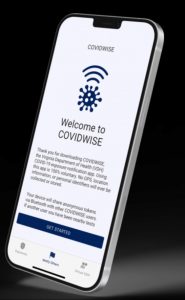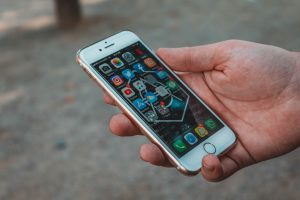Virginia: First in the Fight Against COVID-19
Published on September 24, 2020, at 3:33 p.m.
by Bailey Broughton.
One of the most compelling things to come out of the COVID-19 pandemic was the application of communications technology that emerged and evolved to help ensure the safety of individuals across the country. In April, technology giants Google and Apple worked together to develop ENS, the Exposure Notification System. These two companies, with the assistance of app developers, have been working alongside marketing and public relations agencies across the country to create exposure notification systems, which aid the process of contact tracing for public health authorities. Although many states, including Alabama and North Dakota, were among the first states in the race to attempt a statewide adoption of an exposure notification app, it was Virginia that prevailed and became the first in the fight against COVID-19.
In a collaborative effort between the Virginia Department of Health, Google, Apple and Virginia-based public relations agency Madison+Main, the state of Virginia became a trailblazer in this era of technological adaptation to COVID-19. While it is a great honor for the state to be a pioneer of such a beneficial app, there were countless challenges that accompanied being first.

According to the Virginia Department of Health’s COVIDWISE Fact Sheet, COVIDWISE, the official exposure notification system (ENS) in the state of Virginia, was the first app of its kind to be launched in the United States. It was made available to the public through the App Store and Google Play on Aug. 5. As of Sept. 21, it has been downloaded by 551,178 individuals during the first wave of the campaign — roughly 13% of the target population of Virginians with smartphones between the ages of 18 and 65. According to leaders who oversaw the launch of the app, achieving these numbers was no easy feat. Encouraging positive public awareness played a significant role in executing a successful campaign strategy.
Julie Grimes, public information officer at the Virginia Department of Health, explained that improving public trust in the app was integral to its success and widespread adoption across the state.
Grimes emphasized that the largest challenge of this campaign’s launch was easing the public’s privacy concerns.
“People were worried about the government taking their information and using it for other purposes — we knew this before we even began developing the app,” said Grimes.
David Saunders, chief idea officer of Madison+Main, echoed this statement, explaining that distinguishing the exposure notification system from previous contact tracing apps in a public education campaign was vital to the success of the app.
“Exposure notification is a very different concept from a contact tracing app, and we had to inform people of what the app really was,” Saunders said. “In the public education segment of our campaign, we emphasized that one, the app requires no personal data, and two, it does not track you.”
In fact, one of Madison+Main’s key strategies included reaching out to audiences who were predictably skeptical about downloading the app. Saunders explained that one of the team’s tactics was to single out right-of-center media in the public education approach. This strategy included appearing on conservative talk radio stations to position COVIDWISE as a public/private partnership, rather than a “big brother government program” and informing audiences that the app does not access your private data.
Right-of-center “naysayers,” however, were not the only audience segment that had reservations about the app upon its launch. Saunders explained that public perception also needed improvement in vital minority communities, in which the virus affects individuals disproportionately.
“Latinx communities have a general distrust of the federal government, and African Americans are largely skeptical of public health — and rightfully so,” said Saunders in reference to tragedies such as the Tuskegee Syphilis Study. Thus, these communities were especially important to target in the public education campaign.
Leaders in this public education campaign knew that gaining the public’s trust was the primary challenge that needed to be overcome. Of course, the goal was to get as many downloads as possible to prevent the spread of infection, but the marketers were aware from the beginning that certain audiences would not download the app regardless of public education efforts.
“One-third of Virginians will never take anything the government gives them; that’s just how it’s going to be,” said Saunders. “One-third is going to ask questions about the app, and one-third is just going to download it.”
Another challenge that leaders of the app-launch faced in this campaign was the enormous pressure that accompanied being the very first to launch a statewide ENS. Jeff Stover, executive advisor to the commissioner at the Virginia Department of Health, discussed this concern.
Stover explained that Madison+Main was brought on through a request for proposals process as opposed to establishing an emergency procurement, which would have been much faster. However, state officials felt obligated to do their due diligence in selecting an agency, and finalized the Madison+Main contract 10 days before the app’s official launch.
“There’s an inherent risk to being in the lead,” said Stover. “You can either succeed, or royally mess up.”
Saunders provided reporting details about the media coverage the campaign generated, expressing how important it was for them to set a precedent for exposure notification systems since the entire country was watching Virginia closely.
According to data provided by Saunders and Grimes, in the first 30 days the campaign achieved the following milestones:
•5,342 stories and social media mentions nationally.
•Cash value of media equalling $22 million in the first three weeks of the campaign.
•A global reach of 1.5 billion individuals.
The app’s launch was orchestrated strategically and professionally, which ended up providing a lot of positive press for the Commonwealth of Virginia. However, each individual involved in this campaign understood that if executed poorly, Virginia could receive a lot of bad press. Therefore, the pressure was on for every party involved to represent the state well.

Stover noted that being the first state to successfully launch a COVID-19 exposure notification app was fitting for Virginia, especially given that the Commonwealth is the only state that has a physician as governor. This situation presented a unique opportunity for the state to lead the nation in establishing a working exposure notification system. Saunders, Grimes and Stover alike all emphasized the enormous pressure that accompanied being the first state to launch, but also the great rewards of the campaign.
When discussing the rewards of the ongoing COVIDWISE campaign, Saunders expressed that the nature of the project itself made it a worthwhile endeavor, regardless of the numerous obstacles.
“Public advocacy campaigns are structured differently,” said Saunders. “There’s something in our DNA that makes us work harder to move the needle when we know that we are helping people.”
Although the initial launch of this campaign has concluded, VDH and its marketing partner, Madison+Main, are now transitioning to the second wave of their campaign that includes more traditional forms of advertising, such as billboards, outdoor advertising and live-action public service announcements.
A download percentage goal was not set at the beginning of the campaign, but after reaching 13% of the target audience, the campaign team is aiming for more, according to Grimes.
“We aren’t going to settle or be happy at 15%,” said Grimes. “Ultimately we want as many downloads as possible.”
According to Saunders, a recent modeling effort from Stanford, Google and the University of Oxford suggests that app downloads, at varying percentages of uptake, can have a positive impact on the number of infections, deaths and hospitalizations. The study concluded that one COVID-19 infection could be prevented with every two downloads of the app. Regardless of how one feels about downloading a government-sponsored app on one’s phone, it cannot be denied that exposure notification apps can serve as useful tools for improving prevention strategies and the health of our communities.




